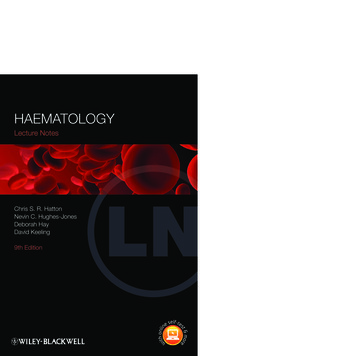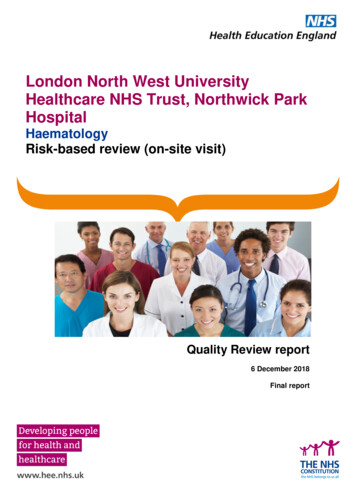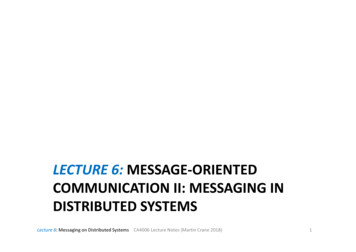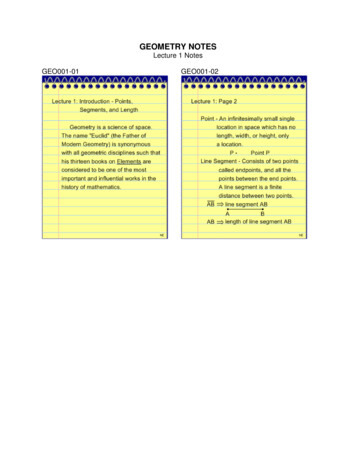
Transcription
HAEMATOLOGYLecture NotesChris S. R. HattonNevin C. Hughes-JonesDeborah HayDavid Keeling9th EditionLN
HaematologyLecture Notes
This new edition is also available as an e-book.For more details, please seewww.wiley.com/buy/9780470673591or scan this QR code:Companion websiteThis book is accompanied by a companion website:www.lecturenoteseries.com/haematologyThe website includes: Key revision points for each chapter in both PowerPoint and PDF format Interactive multiple choice questions for each chapter Figures from the book in PowerPoint format
HaematologyLecture NotesChris S.R. HattonFRCP, FRCPathConsultant HaematologistDepartment of HaematologyThe John Radcliffe Hospital, OxfordNevin C. Hughes-JonesDM, PhD, MA, FRCP, FRSFormer Member of the Scientific StaffMedical Research Council’s Molecular Immunopathology Unit, and of theDepartment of Pathology, University of Cambridge, CambridgeDeborah HayMRCP, FRCPathWellcome Trust Clinical Training FellowMRC Molecular Haematology UnitWeatherall Institute of Molecular Medicine, OxfordDavid KeelingMD, FRCP, FRCPathConsultant HaematologistOxford Haemophilia and Thrombosis Centre, OxfordNinth EditionA John Wiley & Sons, Ltd., Publication
This edition first published 2013 2013 by John Wiley & Sons, LtdWiley-Blackwell is an imprint of John Wiley & Sons, formed by the merger of Wiley’s globalScientific, Technical and Medical business with Blackwell Publishing.Registered office: John Wiley & Sons, Ltd, The Atrium, Southern Gate, Chichester, West Sussex,PO19 8SQ, UKEditorial offices: 9600 Garsington Road, Oxford, OX4 2DQ, UKThe Atrium, Southern Gate, Chichester, West Sussex, PO19 8SQ, UK111 River Street, Hoboken, NJ 07030-5774, USAFor details of our global editorial offices, for customer services and for information about howto apply for permission to reuse the copyright material in this book please see our website atwww.wiley.com/wiley-blackwell.The right of the author to be identified as the author of this work has been asserted in accordancewith the UK Copyright, Designs and Patents Act 1988.All rights reserved. No part of this publication may be reproduced, stored in a retrieval system,or transmitted, in any form or by any means, electronic, mechanical, photocopying, recording orotherwise, except as permitted by the UK Copyright, Designs and Patents Act 1988, without the priorpermission of the publisher.Designations used by companies to distinguish their products are often claimed as trademarks. Allbrand names and product names used in this book are trade names, service marks, trademarks orregistered trademarks of their respective owners. The publisher is not associated with any product orvendor mentioned in this book. This publication is designed to provide accurate and authoritativeinformation in regard to the subject matter covered. It is sold on the understanding that thepublisher is not engaged in rendering professional services. If professional advice or other expertassistance is required, the services of a competent professional should be sought.Library of Congress Cataloging-in-Publication DataLecture notes. Haematology / Nevin C. Hughes-Jones . [et al.]. — 9th ed.p. ; cm.HaematologyRev. ed. of: Lecture notes. Haematology / N.C. Hughes-Jones, S.N. Wickramasinghe, C.S.R.Hatton. 8th ed. 2009.Includes bibliographical references and index.ISBN 978-0-470-67359-1 (pbk. : alk. paper)I. Hughes-Jones, N. C. (Nevin Campbell) II. Title: Haematology.[DNLM: 1. Hematologic Diseases. 2. Blood Physiological Processes. WH 120]616.1’5—dc232012031978A catalogue record for this book is available from the British Library.Wiley also publishes its books in a variety of electronic formats. Some content that appears in printmay not be available in electronic books.Cover image: iStock Activ DesignCover design by Grounded Design Set in 8.5/11pt Utopia Std by Aptara Inc., New Delhi, India12013
ContentsPreface to the first edition viPreface to the ninth edition vii1 An introduction to haematopoiesis, 12 Anaemia: General principles, 103 Haemolytic anaemias, 264 Disorders of globin synthesis, 395 Conditions associated with white cell abnormalities, 516 Structure and function of lymphoid tissue, 597 Lymphomas: General principles, 658 Classification of lymphoma, 739 Neoplastic disorders of lymphoid cells, 7610 Myeloma and other paraproteinaemias, 8711 Neoplastic disorders of myeloid cells, 9312 Bone marrow transplantation, 10413 Aplastic anaemia and pure red cell aplasia, 11014 Haemostasis, abnormal bleeding and anticoagulant therapy, 11415 Blood groups and blood transfusion, 13216 Further reading, 143Index, 147Companion websiteThis book is accompanied by a companion website:www.lecturenoteseries.com/haematologyThe website includes: Key revision points for each chapter in both PowerPoint and PDF format Interactive multiple choice questions for each chapter Figures from the book in PowerPoint format
Preface to the first editionThese lecture notes are designed to supply the basicknowledge of both the clinical and laboratory aspectsof haematological diseases and blood transfusion.The content is broadly similar to that of the coursegiven to medical students by the Department of Haematology at St. Mary’s Hospital Medical School. References have been cited so that those who need toextend their knowledge in any particular field can doso. Most of the journals and books that are mentionedare those commonly found in every library.At the end of each chapter I have supplied learning objectives in studying each disease. There are twomain purposes in these objectives. First, they facilitate the learning process, since the process of acquisition, retention, and recall of data is greatly helped ifthe facts and concepts are centred around a particularobjective. Secondly, many objectives are closely relatedto the practical problems encountered in the diagnosisand treatment of patients. For instance, the followingobjectives: “to understand the method of differentiation of megaloblastic anaemia due to vitamin B12deficiency from that due to folate deficiency” and “tounderstand the basis for the differentiation of leukaemia into acute and chronic forms based on theclinical picture and on the peripheral blood findings”are practical problems encountered frequently in thehaematology laboratory. A point of more immediateinterest to the undergraduate is that examiners setting either multiple choice or essay questions will besearching for the same knowledge that is required inanswering the objectives.I should like to thank Prof. P.L. Mollison, Dr. P.Barkhan, Dr. I. Chanarin, Dr. G.J. Jenkins, and Dr. M.S.Rose for their criticism and helpful suggestions during the preparation of the manuscript and Mrs. IngeBarnett for typing the several drafts and final typescript.N.C. Hughes-Jones
Preface to the ninth editionThe science and practice of haematology continue toadvance at an extraordinary rate. At the same time,the volume of data that medical students are requiredto assimilate across all disciplines continues to expand. Therefore, our aim in revising the text of Lecture Notes in Haematology was to provide a comprehensive overview of this diverse subject in a way thatpromotes understanding of pathophysiological concepts, while highlighting the most up-to-date aspectsof clinical practice. Further, to enhance active learning, we have also provided a companion website withself-test multiple-choice questions and explanations.Dr Sunil Wickramasinghe was actively involved inLecture Notes from its inception in the 1970s until theeighth edition. His tragically premature death in 2009deprives us of a senior author and highly valued colleague. His contribution has been greatly missed.We have been fortunate in having the help of manyof our clinical colleagues for this edition: specialthanks are due to Dr Karthik Ramasamy and Dr AdamMead, both of Oxford University Hospitals, for kindlyreviewing the chapters on myeloma and myeloid malignancies respectively. As in previous editions, wealso express our thanks to Professor Kevin Gatter ofthe Nuffield Department of Clinical and LaboratorySciences, University of Oxford, for generously providing many of the photomicrographs used in this text.As ever, we are grateful to readers who have takenthe time to give us valuable feedback on earlier editions. We hope that the ninth edition of HaematologyLecture Notes provides a useful introduction to thisfascinating area of medicine.Chris S. R. HattonNevin C. Hughes-JonesDeborah HayDavid Keeling
1An introduction tohaematopoiesisLearning objectives To understand the process of formation of blood cells To understand the concept of a stem cell To appreciate the process of lineage specification of blood cells To recognize the different types of mature blood cell To understand the normal role of each mature cell type in the bloodWhere is blood formed?Blood is normally formed early in the process ofembryogenesis, with haemopoietic stem cells originating in the para-aortic mesoderm of the embryo.Primitive red blood cells, platelet precursors andmacrophages are initially formed in the vasculatureof the extra-embryonic yolk sac, before the principalsite of haemopoiesis shifts to the fetal liver at aroundfive to eight weeks’ gestation. The liver remains themain source of blood in the fetus until shortly beforebirth, although the bone marrow starts to develophaemopoietic activity from as early as 10 weeks’gestation.After birth, the marrow is the sole site of haemopoiesis in healthy individuals. During the first fewyears of life, nearly all the marrow cavities containred haemopoietic marrow, but this recedes such thatby adulthood haemopoiesis is limited to marrow inthe vertebrae, pelvis, sternum and the proximal endsof the femora and humeri, with minor contributionsfrom the skull bones, ribs and scapulae.Although the sites of haemopoiesis in the adult aretherefore relatively limited, other sites retain their capacity to produce blood cells if needed. In conditionsin which there is an increased haemopoietic drive(such as chronic haemolytic anaemias and chronicmyeloproliferative disorders), haemopoietic tissuewill expand and may extend into marrow cavitiesthat do not normally support haemopoiesis in theadult. Foci of haemopoietic tissue may also appear inthe adult liver and spleen (known as extramedullaryhaemopoiesis).Haemopoietic stem cellsThe process of haemopoiesis involves both the specification of individual blood cell lineages and cellularproliferation to maintain adequate circulating numbers of cells throughout life. This is accomplished using the unique properties of haemopoietic stem cells.Long-term haemopoietic stem cells (HSCs) in thebone marrow are capable of both self-renewal anddifferentiation into the progenitors of individualblood cell lineages. The progenitor cells of individuallineages then undergo many rounds of division andfurther differentiation in order to yield populations ofmature blood cells. This process can be represented asa hierarchy of cells, with HSCs giving rise to populations of precursor cells, which in turn give rise to cellsincreasingly committed to producing a single type ofmature blood cell (Figure 1.1). Thus, the immediateprogeny of HSCs are the multipotent progenitor cells,which have limited self-renewal capacity but retainHaematology Lecture Notes, Ninth edition. C.S.R. Hatton, N.C. Hughes-Jones, D. Hay and D. Keeling. 2013 John Wiley & Sons, Ltd.Published 2013 by John Wiley & Sons, Ltd.
2An introduction to haematopoiesisLong-term HSCShort-term HSCCommon lymphoidprogenitorPrecursorB cellPrecursorT cellNK cellprecursorsB cells,plasmacellsT helpercells,cytotoxicT cellsNK BasophilCommon myeloidprogenitorGMPNeutrophiland eFigure 1.1 A schematic representation of the process of haemopoiesis. Multipotent stem cells give rise to lymphoid(pink) and myeloid (blue) lineages. The myeloid lineage further divides into granulocytic, erythroid and megakaryocytic(platelet) lineages. As cells progress through this process of differentiation, they accrue more functional specializationand lose their multipotency.Abbreviations: HSC – haemopoietic stem cell; MEP – megakaryocyte/erythroid progenitor; GMP – granulocytemacrophage progenitor; NK – natural killerthe ability to differentiate into all blood cell lineages.Although there is still debate about exactly how lineage restricted subsequent precursors are, the conceptof sequential and irreversible differentiation is widelyaccepted. In Figure 1.1, the HSC is seen giving rise totwo major lineages: the lymphoid lineage, in which acommon lymphoid progenitor gives rise to B and Tcells; and a myeloid lineage, with a common myeloidprogenitor giving rise to red cells, granulocytes andplatelets. The division of haemopoiesis into myeloidand lymphoid compartments is fundamental to anunderstanding of haematological disease.The process of haemopoiesis outlined abovehas several advantages. First, it permits the massive
An introduction to haematopoiesisexpansion of cell numbers needed to maintain an adequate population of mature blood cells. It also meansthat the production of each type of mature blood cellcan be controlled individually, tailoring production tospecific physiological requirements. Finally it requiresrelatively little proliferative activity on the part of thelong-term HSCs themselves, thereby minimizing therisk of developing mutations in these crucial cellsduring DNA replication and cell division.HSCs were first detected and defined functionally through experiments in which a subset of cellsfrom the bone marrow were shown to produce bloodcells of all lineages when transplanted into lethallyirradiated mice, which have no haemopoietic potential of their own. Subsequent work has used cellsurface markers and flow cy
Lecture Notes from its inception in the 1970s until the eighth edition. His tragically premature death in 2009 deprives us of a senior author and highly valued col-league. His contribution has been greatly missed. We have been fortunate in having the help of many of our clinical colleagues for this edition: special thanks are due to Dr Karthik Ramasamy and Dr Adam Mead, both of Oxford .










